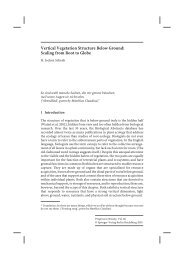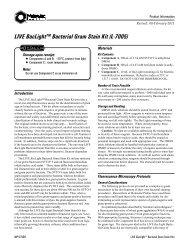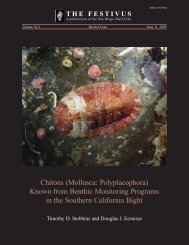Landscape Evolution at an Active Plate Margin - Biological Science ...
Landscape Evolution at an Active Plate Margin - Biological Science ...
Landscape Evolution at an Active Plate Margin - Biological Science ...
Create successful ePaper yourself
Turn your PDF publications into a flip-book with our unique Google optimized e-Paper software.
Nevada. Fish Slough, with 126 wetl<strong>an</strong>d taxa, has the<br />
richest flora of <strong>an</strong>y of the nine areas surveyed. Fish<br />
Slough wetl<strong>an</strong>d flora is most similar to Fish Lake<br />
Valley <strong>an</strong>d Deep Springs Valley to the east, <strong>an</strong>d least<br />
similar to Saline Valley. Fish Slough is outst<strong>an</strong>ding,<br />
since 34 of its species do not occur <strong>at</strong> <strong>an</strong>y of the nine<br />
other wetl<strong>an</strong>d areas surveyed. Species with primarily<br />
Mojave<strong>an</strong> (8 percent) <strong>an</strong>d Gre<strong>at</strong> Basin (10 percent)<br />
distribution are about equally represented in Fish<br />
Slough wetl<strong>an</strong>ds.<br />
Several protected pl<strong>an</strong>ts thrive here: Fish Slough milk<br />
vetch (Astragalus lentiginosus var. piscinensis) is a federally<br />
listed thre<strong>at</strong>ened species. You c<strong>an</strong>not find this<br />
low-growing perennial forb <strong>an</strong>ywhere in the world<br />
except the alkali meadows of Fish Slough. Nearby are<br />
white flowers of the Inyo County star-tulip, the Alkali<br />
mariposa lily (Calochortus excav<strong>at</strong>us; BLM Sensitive<br />
Species). Five other rare pl<strong>an</strong>t species depending on<br />
the Fish Slough are alkali cordgrass (Spartina gracilis),<br />
hot springs fimbry (Fimbristylis), hot spring fimbristylis<br />
(Fimbristlis thermalis), Gre<strong>at</strong> Basin centaury<br />
(Zeltnera exalt<strong>at</strong>a Syn: Centaurium (Centarium<br />
exalt<strong>at</strong>um), King’s mousetailivesia (Ivesia kingii var.<br />
kingii), <strong>an</strong>d silverleaf milk vetch (Astragalus argophyllus<br />
var. argophyllus).<br />
Fish Slough is also critical aqu<strong>at</strong>ic habit<strong>at</strong> for the<br />
Owens pupfish (Cyprinodon radiosus), Owens tui<br />
chub (Gila bicolor snyderi), <strong>an</strong>d the Fish Slough<br />
springsnail (Pyrgulopsis pertub<strong>at</strong>a). Owens pupfish<br />
was found throughout the Owens Valley from 1859<br />
to 1916, but w<strong>at</strong>er diversions <strong>an</strong>d wetl<strong>an</strong>d drainage<br />
by farmers caused the fish to drastically decline until<br />
they were thought to be extinct in 1948. Two of Fish<br />
Slough’s species, the Owens pupfish <strong>an</strong>d the Owens<br />
tui chub, are listed as end<strong>an</strong>gered. In 1982, the Bureau<br />
design<strong>at</strong>ed Fish Slough as <strong>an</strong> Area of Critical Environmental<br />
Concern (ACEC) to preserve the unique<br />
aqu<strong>at</strong>ic ecosystem (BLM, 2002) – but a small popul<strong>at</strong>ion<br />
was rediscovered in Fish Slough. These pupfish<br />
feed on insect larvae <strong>an</strong>d small aqu<strong>at</strong>ic cre<strong>at</strong>ures <strong>an</strong>d<br />
c<strong>an</strong> survive in warm, salty w<strong>at</strong>er with low oxygen<br />
levels (see Schoenherr, this volume). The males turn<br />
blue <strong>an</strong>d silver during breeding season <strong>an</strong>d vigorously<br />
defend small territories. The Owens speckled dace is<br />
a subspecies of speckled dace found in some places in<br />
the Owens River. Fish <strong>an</strong>d Game hopes to reintroduce<br />
the Owens tui chub to the Slough.<br />
RETRACE to Highway 6.<br />
21.1 (0.4) Resume pavement.<br />
D. R. Jessey <strong>an</strong>d R. E. Reynolds<br />
24.2 (3.1) Stop <strong>at</strong> Highway 6. TURN RIGHT (south).<br />
25.4 (1.2) Enter Bishop.<br />
25.7 (0.3) Stop <strong>at</strong> signal <strong>an</strong>d TURN RIGHT (northwest)<br />
on Highway 395.<br />
27.2 (1.5) Traffic light <strong>at</strong> Barlow Road. Proceed on<br />
Highway 395.<br />
31.7 (4.5) Sawmill/Pleas<strong>an</strong>t Valley roads junction.<br />
Outcrops of Bishop Tuff are present on both sides of<br />
US 395. Ahead on the skyline is the escarpment of<br />
Wheeler Crest, composed of Wheeler Crest Gr<strong>an</strong>odiorite.<br />
Proceed on Hwy 395.<br />
34.3 (2.6) Continue past Mill Creek Road.<br />
35.6 (1.3) Continue past Pine Creek Road. If you w<strong>an</strong>t<br />
to visit the ab<strong>an</strong>doned Pine Creek tungsten mine,<br />
turn left <strong>an</strong>d drive 10 miles west along Pine Creek<br />
C<strong>an</strong>yon Road to a locked g<strong>at</strong>e. The mine lies about 0.5<br />
mile beyond the g<strong>at</strong>e. The mine was closed in 1990<br />
<strong>an</strong>d more recently (2001) the existing mill was sold<br />
<strong>an</strong>d dism<strong>an</strong>tled. About 600 people worked <strong>at</strong> Pine<br />
Creek during its World War II heyday. The mine beg<strong>an</strong><br />
production of tungsten in 1918 <strong>an</strong>d was acquired<br />
by Union Carbide in 1936. Union Carbide sold the<br />
mine <strong>an</strong>d mill to Str<strong>at</strong>egic Minerals Corpor<strong>at</strong>ion in<br />
1986. Avocet Ventures bought the mill <strong>an</strong>d 50 percent<br />
of the mine in 1995.<br />
The mine was the largest tungsten supplier in the U.S.<br />
Between 1937 <strong>an</strong>d 1990, 83,600 tons of WO 3 (tungsten<br />
trioxide), 12,700 tons of molybdenum byproducts,<br />
18,300 tons of copper, 1.8 million ounces of silver,<br />
<strong>an</strong>d 3600 ounces of gold were produced (Kurtak,<br />
1997). The ore occurs as a contact metamorphic skarn<br />
formed when Paleozoic roof pend<strong>an</strong>t rocks reacted<br />
with hydrothermal fluids gener<strong>at</strong>ed by intrusion of<br />
the Sierra Nevada b<strong>at</strong>holith. Continue straight on<br />
Hwy 395 around the western edge of Round Valley.<br />
37.2 (1.6) Begin the climb up the Sherwin Grade.<br />
Highway 395 ascends 2500 feet over the next 10<br />
miles. The grade is named for James Sherwin, owner<br />
of a r<strong>an</strong>ch in Round Valley. In 1874, Sherwin built a<br />
toll road up the grade of Rock Creek to the vicinity<br />
of present-day Toms Place. For years, U.S. Highway<br />
395 followed the winding route of Sherwin’s toll road,<br />
until the existing four-l<strong>an</strong>e highway was built in<br />
1956–57 across the volc<strong>an</strong>ic tablel<strong>an</strong>d.<br />
37.5 (0.3) Prepare to turn right; look for “Paradise/<br />
Swale” sign.<br />
32 2009 Desert Symposium
















